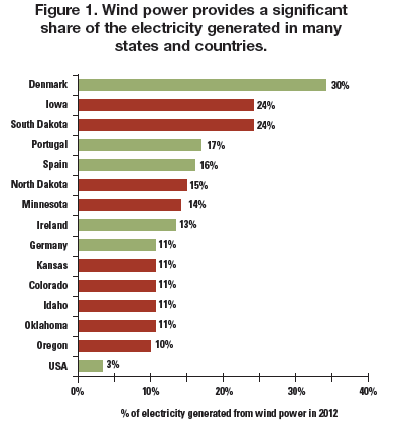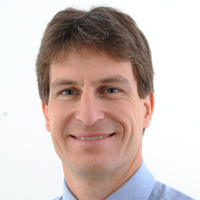UCS has just released a new report that I co-authored called Ramping up Renewables: Energy You Can Count On. It shows that renewable energy is already providing more clean, reliable electricity in the United States and around the world than many people thought possible just a few years ago. It also shows that we have the tools to accommodate considerably more wind and solar in the U.S. electricity system, as well as reach much higher levels in the future.
 This post is part of a series on Ramping Up Renewables: Clean Energy Policies to Watch in 2013.
This post is part of a series on Ramping Up Renewables: Clean Energy Policies to Watch in 2013.
Subscribe to the series RSS feed.
Renewables are providing a significant source of electricity in many states and countries
Wind and solar power increased nearly four-fold in the United States from 2007 to 2012, and has been growing at even higher rates in other countries. New U.S. records were set for both wind and solar in 2012, which provided more than half of the total new electricity generating capacity installed in the country. Because of this growth, many states and countries are already achieving high penetrations of these clean power sources. For example:
- Wind power provided more than 10% of the electricity generated in nine states in 2012, with Iowa and South Dakota leading the pack at 24%.
- Denmark is the global leader, with wind power providing 30% of the country’s electricity in 2012, followed by Portugal (17%), Spain (16%), Ireland (13%) and Germany (11%).
- Germany is the global leader in solar photovoltaics (PV), which can currently provide more than half of the nation’s electricity on hot sunny days when demand is high.
- California leads the U.S. in installed solar PV capacity, followed by Arizona and New Jersey, which can all supply 5% or more of electricity demand on sunny days.
- On specific days in 2012 and early 2013, wind power supplied more than 30% of Texas, Kansas, and Oklahoma’s electricity; 25% of the Midwest’s electricity; and more electricity than hydropower for the first time in the Pacific Northwest.

Utilities are integrating high levels of renewable energy
Some of the nation’s largest utilities are also relying on significant levels of renewable energy. For example:
- Renewables supplied 21% of the electricity Southern California Edison (SCE) sold to its 14 million customers in 2011, which included 7.5% from wind and solar. SCE projects that wind and solar will supply 18% of its retail electricity sales by 2017, as the utility works to meet California’s renewable electricity standard (RES) of 33% by 2020.
- In Minnesota, Xcel Energy projects that wind and other renewable sources will rise from 19% of annual electricity sales in 2012 to 30% by 2020, to meet the state’s RES.

Xcel Energy’s Cedar Creek Wind Farm near Grover, CO, helped the utility generate 57 percent of its electricity from wind one night in spring 2012—a U.S. record.
Source: National Center for Atmospheric Research 2011.
We have the tools to significantly ramp up renewable energy and maintain reliability
Transitioning to a system that relies heavily on wind and solar does pose challenges to managing the electricity grid. After all, the wind doesn’t always blow and the sun doesn’t always shine. However, meeting electricity demand in the face of variability and uncertainty is not a new concept for grid operators. They already make adjustments for constantly changing demand, planned power plant outages for maintenance, and outages stemming from severe weather, equipment failure, and other unexpected events. Adding variable energy sources to the system may increase the complexity of the challenge, but does not pose insurmountable technical problems or significant costs.
Fortunately, we have the tools to significantly ramp up renewable energy use and keep the lights on, while lowering costs and reducing emissions. These tools include:
- Geographic dispersion. Integrating wind and solar projects over larger areas helps smooth out an uneven supply of power from individual projects.
- Better forecasting. Some larger utilities and regional grid operators are using weather observations, meteorological data, computer models, and statistical analysis to project wind and solar output, reduce power and reserves from fossil fuels, and cut costs.
- Improved scheduling. Because wind and sunlight can fluctuate, allowing operators to schedule power delivery on a sub-hourly basis can make the grid more efficient.
- More flexible power plants. When wind and solar power diminishes, grid operators can use reserve power sources, such as hydro and quick-starting natural gas plants, to fill the gap.
- Building new transmission lines to deliver high-quality wind and large-scale solar from remote areas to cities, and to provide stronger links between regional grids and utilities.
- Managing customer demand. Paying customers to reduce electricity use when demand is high is often the least expensive way to manage variability on the grid.
- Creating a smarter grid. New technologies in sensing, communications, control, and power electronics can enable grid operators to integrate larger volumes of renewable power.
- Storage. Several technologies are now available to store electricity from renewables for use when demand is high and to manage variability on the grid.
With strong policies, renewable energy could provide 80% of U.S. electricity use 2050
With these tools in hand, we can ramp up renewable energy to much higher levels. At least 18 countries have binding renewable electricity targets. For example, Germany has a binding target to produce at least 35 percent of its electricity from renewable sources by 2020, rising to 80 percent by 2050. While the U.S. does not have a national target or other long-term policy to expand the use of renewable energy, 29 states have adopted renewable standards.
As I described in a blog last August, a 2012 study by the National Renewable Energy Laboratory (NREL) found that renewable energy technologies available now could supply 80 percent of U.S. electricity in 2050. Using many of the tools described above, the study found that wind and solar alone could provide nearly half of U.S. electricity in 2050, while meeting demand every hour of the year in every region of the country. To get there, we need to make smart investments and policy decisions today that move the country toward a cleaner energy future.
